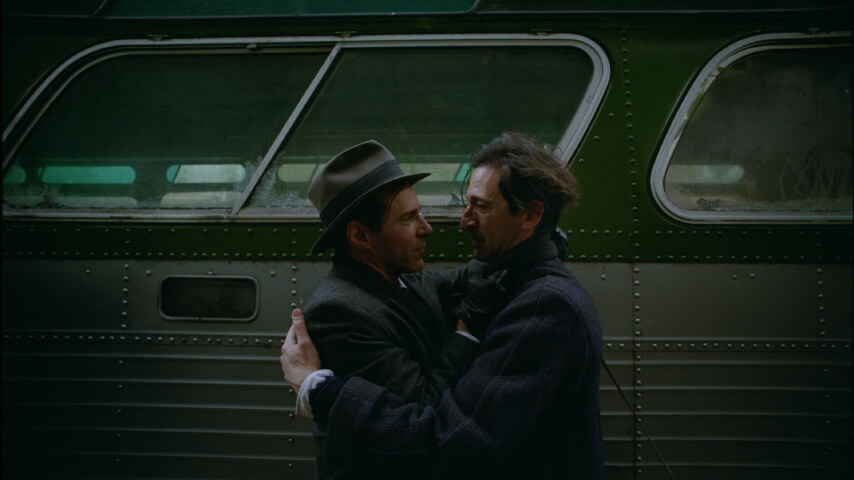László is too embarrassingly foreign for his fully assimilated cousin, who readily abandons the architect in the fallout of the library debacle. Instead, Harrison, having researched László’s esteemed body of work, comes calling with an offer for a grand project: a community center and church memorializing his recently deceased mother. László sets up shop in the guest house of Harrison’s mansion, drawing up plans for his brutalist structure. He awaits the arrival of his wife Erzsébet (Felicity Jones) and his mute, orphaned niece Zsófia (Raffey Cassidy), both still imprisoned at Dachau, and sustains a heroin addiction driven by an injury while escaping the Nazis.
László’s success with the Van Buren family—if you want to call it that—rests entirely on his image as a “good foreigner.” Harrison is happy to entertain his like-minded peers by explaining to them that not only is László an acclaimed architect, he is also acclaimed specifically in Western and Central Europe. And when Erzsébet and Zsófia are finally reunited with László, the Van Burens are delighted to learn of Erzsébet’s education as a journalist. The Van Burens—including Harry’s twin sister Maggie (Stacy Martin)—barely hide their cruelty behind their polite smiles and frivolous manners. Because they see that László has “potential,” they allow him to reside with them in glorious Doylestown, Pennsylvania like a stray dog that could one day be trained.
Racism and persecution guide László’s brutalist designs, erecting a monument meant to mirror the prison which held him in Buchenwald, to the complete ignorance of the Van Burens. With the (obvious) reveal of László’s artistic intentions late in the film, The Brutalist’s Israel references come across somewhat conflicting. Is László’s structure a memorial, or is it just another prison? Is Israel truly free for the Jews, or is it more similar to America than the Tóths care to admit? The Brutalist tip-toes around the issue and the questions it sparks, too annoyingly subtle to spark outrage from either side. But the building is outwardly less memorializing than it is blanketly intimidating. Shots inside the structure—filmed magnificently by cinematographer Lol Crawley—are sometimes evocative and deeply shadowed, other times stark and plain, the intensity of the raw concrete enough to threaten on its own.
In fact all of The Brutalist, filmed in stunning VistaVision and screened on 70mm, is thrillingly composed. Across its three-and-a-half-hour runtime, it grapples with themes of assimilation, American mythology, colonization, and self-imprisonment; although, by the second half of the film the story feels wanting. The Brutalist hinges upon the sum of its parts, similar to Corbet’s more divisive Vox Lux, which also dealt conflictingly with America-specific trauma. Still, there is a cynicism that separates The Brutalist from your typical immigrant rags-to-riches tale. László is tormented, his relationship with Erzsébet is deeply troubled, and Jones’ performance is one of pain and vulnerability toughened by unspeakable suffering. But the boilerplate nature of the narrative (co-written by Corbet and Mona Fastvold) undercuts the technical strengths, and emphasizes some of the other various hitches along the way. Isaach de Bankolé’s character, for example, exists to show that László is compassionate to Black people during this difficult era, and there is a shocking literalization of Harrison and László’s relationship that leaves little room for nuance.
There are also obvious similarities between The Brutalist and There Will Be Blood, between László Tóth and Daniel Plainview, between the sprawling American epics about men who lose themselves to their creations and the false promises of capitalism. The oppressive, overpowering cranes of László’s construction parallel Plainview’s oil rigs. Both men look for freedom from poverty within a system that merely offers them another form of captivity. Still, László’s story, and his character, felt less engrossing. It’s fitting to have a Great American Epic center on a Holocaust survivor, to see how America’s promises still come with a price to those fleeing abject slaughter—how assimilation becomes servitude. But as The Brutalist is operating in the shadow of a tradition of cinematic epics, there is an expected journey the film has the opportunity to stray from, and it doesn’t nearly enough. Brody’s sad eyes and tousled hair are ideal for playing a sympathetic survivor, yet László’s character is never taken into far, dark places. It’s hard to leave without wanting a little more from The Brutalist’s themes; most of what enthralls in the film is due to its technical construction.
Corbet has spoken about how tiring it was to get his film made, how it took seven years and how bitter he is towards the relationship between patron and artist, like that of Harrison and László. The making of The Brutalist and the making of the community center were both grueling struggles in the face of consistent setbacks. László’s building plagues him for years, hardens him, distances him from his wife and indentures him, eventually, to the Van Burens. And for what? To memorialize his fallen kin with a reminder of their suffering that only caused years of his own, to receive late-in-life recognition at a tribute gala that feels more like a wake. Is this conclusion a celebration, or a reminder of the perpetuation of imprisonment? The Brutalist is impressive, but like the technically brilliant construction at its core, never feels wholly worthy of the suffering put into it.
This review originally ran on October 1, 2024 alongside the film’s New York Film Festival premiere.
Director: Brady Corbet
Writer: Brady Corbet, Mona Fastvold
Starring: Adrien Brody, Felicity Jones, Joe Alwyn, Alessandro Nivola, Jonathan Hyde, Guy Pearce
Release Date: December 20, 2024

